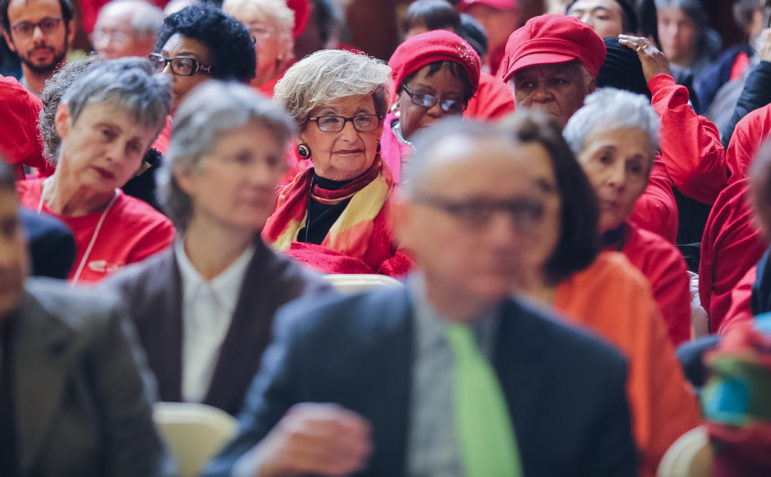
William Alatriste for the City Council
Senior citizens look on at a City Council hearing on policies for the aging in 2017.
New York State’s senior population is growing and diversifying– especially within in the five boroughs. But a new study shows how race and income inequality continues to affect quality of life, even during the twilight years.
The report released Wednesday by the Center for An Urban Future analyzes data from the American Community Survey in 2007 and 2017 to get a snapshot of changes in the senior population.
The big picture findings validate the well-known narrative of a soaring population of older people: The population of New Yorkers statewide who are 65 and older jumped 26 percent in just 10 years, or by 647,000. The state’s overall population? It grew by just 3 percent.
One in seven of those older New Yorkers are in poverty, with larger rates of poverty in Black, Latino, Asian and immigrant communities.
And it’s not just the over-65 population that is jumping. The over-85 population—those who need the most care—has also increased 26 percent, and is now at 444,005 statewide.
Get the best of City Limits news in your inbox.
Select any of our free weekly newsletters and stay informed on the latest policy-focused, independent news.
The study singles out U.S.-born Latino New Yorkers as the senior population with the highest rate of poverty, at 26 percent. Second are Asian seniors with a poverty rate of 22 percent; Black older adults display a poverty rate of 19 percent.
While the overall statewide elder poverty rate decreased 2 percent, senior poverty rates are increasing in many parts of the state, including in New York City. Rochester saw its share of elders in poverty jump 38 percent, and has the highest senior poverty rate of any county or city in the state. It’s followed by New York City and Buffalo, where adults older than 65 have a poverty rate of 20 percent.
There are some bright spots: Yonkers, the “oldest” major city in the state (17 percent of its population is 65 or above) saw a 10 percent decrease in the older-adult poverty rate, the sharpest decrease in the state. It’s unclear what accounts for this decrease. The growth in seniors in Yonkers has mostly been among Latinos, a population that tripled in the 10-year period of the report.
The suburbs outside New York City are getting also getting significantly older and, in some cases, those older populations are growing poorer. The foreign-born elder population increased faster than the native-born elder population in both Nassau and Suffolk counties.
Similar to Long Island, the report shows that much of the growth in the senior population in the five boroughs is driven by the aging of the foreign-born. Over 10 years ending in 2017, the population of adults 65 and older increased by 33 percent in Manhattan. In the Bronx, 26 percent. In Staten Island, 27 percent. In Queens, 22 percent. And in Brooklyn, by 18 percent.
Brooklyn may evoke images of millennials, but the borough has the highest population of those over 65 (though not the highest percentage of its population) at 357,855, more than any other county in the state. Brooklyn’s elder population growth was entirely the result of foreign-born seniors, whose population grew 39 percent. The native-born senior population in the borough decreased by 3 percent in the same period, so that 58 percent of Brooklyn’s older adults were immigrants in 2017.
In Queens, the picture is similar: The foreign-born older population increased 45 percent, and as of 2017, 60 percent of the boroughs seniors are immigrants. The native-born elder population, meanwhile, decreased 2 percent. The number of older adults in poverty increased 10 percent.
The Bronx saw the largest increase in the city of seniors in poverty, a jump of 36 percent—from 37,517 in 2007 to 51,102 in 2017. Three quarters of that borough’s elder population is non-white. The number of older immigrants in the borough jumped 67 percent. The white older population in borough decreased by 23 percent.
The report only makes one policy recommendation, pointing out that the state’s Office for the Aging spends 40 percent less per older New Yorker than it did in 2000, a result of the older population boom and inflation that has not been addressed in budget increases. The report will likely have implications for many other aspects of senior services, including senior center budgets, which advocates have complained are not funded proportionate to need.









